The Fellow Craft Mason Series – Part I: The Work of Integration
Download MP3At the telegraph masons level, we're going to explore the different workings as well, just
like we did with the interim pranis masons over the past week, from both a practical perspective,
a sort of relational perspective and then a philosophical perspective.
When we talk about the practical level, the practical interpretation of the telegraph
masons work, what we're really talking about is learning how the different skills and activities
that you're pursuing start to fit together.
And you'll see this a lot throughout the telegraph masons kind of toolkit.
A lot of it is about understanding the relationships between things.
When we look at the work itself, it's about understanding, for example, what, if you
imagine an operative capacity, how the tools are used in conjunction with each other to
help create an outcome.
As opposed to the interter pranis masons approach, which is very much more kind of a big heavy
lifting stuff, moving rough objects and concepts around.
At a telegraph level, you're starting to understand more of the interrelationships between
these concepts, how they fit together and how they work.
This is the beginning of the phase of learning where you start to take a meaningful control
over the learning process.
You start proactively seeking feedback.
You start trying to understand, really, again, how the pieces of the work fit together,
as well as maybe the beginning of the understanding of where your strengths lie, where your weaknesses
lie.
And that, beginning that feedback cycle, using other people's expertise, not just as a
guide, but reflecting with your own experience, which has started to kind of nurture and develop
to create a feedback loop that you can use to really understand what's going on.
This sort of behavioral perspective of the fellow craft means that you're going to start
to get an understanding of, again, as well, where your skills lie on a spectrum of skills
related to what you're trying to learn.
So if you're trying to learn, say, music as a rough example, there are tons and tons
and tons of different musical skills that are all related in the music acquisition process.
So there are skills specific to the instrument you're learning, for example, there are skills
relative to training your ear, training your manual dexterity.
There are skills relative to training your ability to read music and then turn that into
the correct motion of your hands or your breath or things like that.
There are tons of subskills as well that kind of all play together.
And as a fellow craft, you really start to get an understanding of what those subskills
are and how they fit together, again, to create that larger moving piece.
You'll know you've hit that fellow craft kind of space in your sort of practical development
when you begin to realize how big the sort of space is of any one of the domains you're
trying to learn in.
You don't really have a sense of scale and scope as an enter apprentice because you don't
have that kind of relationship mindset or perspective.
As a fellow craft, you definitely get a sense that like these skills are big, there's
lots to learn, the pieces all fit together just a little bit differently.
And you begin to surface what your kind of interests and strengths are in that space.
So you're taking this sort of relational feedback not only from the experts around you in the
field, but as well as your own internal lived experience.
So that's kind of the behavioral practical function in the fellow craft nasons degree.
Creators and Guests

